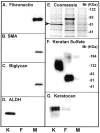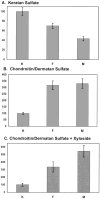Keratocyte phenotype mediates proteoglycan structure: a role for fibroblasts in corneal fibrosis
- PMID: 12933807
- PMCID: PMC2877919
- DOI: 10.1074/jbc.M303292200
Keratocyte phenotype mediates proteoglycan structure: a role for fibroblasts in corneal fibrosis
Abstract
In pathological corneas, accumulation of fibrotic extracellular matrix is characterized by proteoglycans with altered glycosaminoglycans that contribute to the reduced transparency of scarred tissue. During wound healing, keratocytes in the corneal stroma transdifferentiate into fibroblasts and myofibroblasts. In this study, molecular markers were developed to identify keratocyte, fibroblast, and myofibroblast phenotypes in primary cultures of corneal stromal cells and the structure of glycosaminoglycans secreted by these cells was characterized. Quiescent primary keratocytes expressed abundant protein and mRNA for keratocan and aldehyde dehydrogenase class 3 and secreted proteoglycans containing macromolecular keratan sulfate. Expression of these marker compounds was reduced in fibroblasts and also in transforming growth factor-beta-induced myofibroblasts, which expressed high levels of alpha-smooth muscle actin, biglycan, and the extra domain A (EDA or EIIIA) form of cellular fibronectin. Collagen types I and III mRNAs were elevated in both fibroblasts and in myofibroblasts. Expression of these molecular markers clearly distinguishes the phenotypic states of stromal cells in vitro. Glycosaminoglycans secreted by fibroblasts and myofibroblasts were qualitatively similar to and differed from those of keratocytes. Chondroitin/dermatan sulfate abundance, chain length, and sulfation were increased as keratocytes became fibroblasts and myofibroblasts. Fluorophore-assisted carbohydrate electrophoresis analysis demonstrated increased N-acetylgalactosamine sulfation at both 4- and 6-carbons. Hyaluronan, absent in keratocytes, was secreted by fibroblasts and myofibroblasts. Keratan sulfate biosynthesis, chain length, and sulfation were significantly reduced in both fibroblasts and myofibroblasts. The qualitatively similar expression of glycosaminoglycans shared by fibroblasts and myofibroblasts suggests a role for fibroblasts in deposition of non-transparent fibrotic tissue in pathological corneas.
Figures






Similar articles
-
Keratocyte phenotype is enhanced in the absence of attachment to the substratum.Mol Vis. 2008 Feb 9;14:308-17. Mol Vis. 2008. PMID: 18334944 Free PMC article.
-
Proteoglycan expression during transforming growth factor beta -induced keratocyte-myofibroblast transdifferentiation.J Biol Chem. 2001 Nov 23;276(47):44173-8. doi: 10.1074/jbc.M107596200. Epub 2001 Sep 12. J Biol Chem. 2001. PMID: 11555658 Free PMC article.
-
Altered fine structures of corneal and skeletal keratan sulfate and chondroitin/dermatan sulfate in macular corneal dystrophy.J Biol Chem. 2001 Oct 26;276(43):39788-96. doi: 10.1074/jbc.M103227200. Epub 2001 Aug 20. J Biol Chem. 2001. PMID: 11514545
-
The molecular basis of corneal transparency.Exp Eye Res. 2010 Sep;91(3):326-35. doi: 10.1016/j.exer.2010.06.021. Epub 2010 Jul 3. Exp Eye Res. 2010. PMID: 20599432 Free PMC article. Review.
-
Corneal epithelial basement membrane: Structure, function and regeneration.Exp Eye Res. 2020 May;194:108002. doi: 10.1016/j.exer.2020.108002. Epub 2020 Mar 13. Exp Eye Res. 2020. PMID: 32179076 Free PMC article. Review.
Cited by
-
Keratocyte mechanobiology.Exp Eye Res. 2020 Nov;200:108228. doi: 10.1016/j.exer.2020.108228. Epub 2020 Sep 10. Exp Eye Res. 2020. PMID: 32919993 Free PMC article. Review.
-
Establishment of an untransfected human corneal stromal cell line and its biocompatibility to acellular porcine corneal stroma.Int J Ophthalmol. 2012;5(3):286-92. doi: 10.3980/j.issn.2222-3959.2012.03.07. Epub 2012 Jun 18. Int J Ophthalmol. 2012. PMID: 22773974 Free PMC article.
-
Dental pulp stem cells: a new cellular resource for corneal stromal regeneration.Stem Cells Transl Med. 2015 Mar;4(3):276-85. doi: 10.5966/sctm.2014-0115. Stem Cells Transl Med. 2015. PMID: 25713466 Free PMC article.
-
Hyaluronan synthesis mediates the fibrotic response of keratocytes to transforming growth factor beta.J Biol Chem. 2010 Oct 15;285(42):32012-9. doi: 10.1074/jbc.M110.127183. Epub 2010 Aug 4. J Biol Chem. 2010. PMID: 20685654 Free PMC article.
-
Differentiation Capacity of Human Mesenchymal Stem Cells into Keratocyte Lineage.Invest Ophthalmol Vis Sci. 2019 Jul 1;60(8):3013-3023. doi: 10.1167/iovs.19-27008. Invest Ophthalmol Vis Sci. 2019. PMID: 31310658 Free PMC article.
References
Publication types
MeSH terms
Substances
Associated data
- Actions
Grants and funding
LinkOut - more resources
Full Text Sources
Other Literature Sources
Medical

